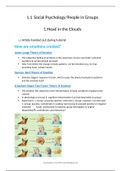lOMoARc2
1.1 Social Psychology/People in Groups
1.Head in the Clouds
1.1 Article handed out during tutorial
How are emotions created?
James-Lange Theory of Emotion
The subjective feeling of emotions is the awareness of your own body´s physical
reactions to certain stimuli (arousal)
Only if we detect the change in body patterns, we feel emotion (e.g. for fear,
pounding heart, sweaty hands)
Cannon- Bard Theory of Emotion
Stimulus triggers response in brain, which causes the physical symptoms/patterns
and the emotion itself
Schachter-Singer Two-Factor Theory of Emotion
The emotion felt, depends on the interpretation of body symptoms relating to the
context
1) physiological arousal 2) cognitive interpretation (can bed depended on group)
Experiment: 1. Group: arousing injection, informed 2. Group: injection, not informed
3. Group: placebo, confederate in waiting room trying to provoke positive or negative
emotions result: uninformed & injection group felt happier or angrier
(depending on confederate cues/behaviour)
Downloaded by Paul Belitz (paulbelitz@gmx.de)
, lOMoARc2
Confederate = appears as a research participant, but is part of the research team
Affective neuroscience= field that uses cognitive neuroscience to study emotions
Some brain areas are activated in all emotion
Others are related to specific emotions (amygdala= fear)
Functions of Emotions (is there a use?)
Helpful emotions like fear, prepare the body for a fight or an escape
Evolutionary benefits (aggression increases chances of survival)
Joy can help us recover from stress
Anger narrows our focus and lets us concentrate on the obstacle ahead
Fear could make you concerned about the outcome of something (exactly what could
be needed)
Emotions can:
- change how we perceive and think
- effect information processing
- affect memory
Zillmann´s Excitation Transfer Model
Residual excitement from previous arousing stimulus intensifies later emotional
state
arousal stays in nervous system and enhances later emotions
any emotion arises from 3 things:
a) a learnt behaviour
b) arousal from another source
c) person´s interpretation of arousal
Downloaded by Paul Belitz (paulbelitz@gmx.de)
, lOMoARc2
Love at First Fright: Rollercoaster experiment by
Meston & Frohlich (2002)
Goal of study:
to examine the effect of residual nervous system arousal (here after rollercoaster) on
perception of sexual attraction, under consideration of romantic and non-romantic
partners, male & female
Relates to Zillerman´s Excitation Transfer Theory (arousal stays in nervous system
and enhances later emotions)
Methodology:
Testing one group of subjects before and one after a rollercoaster ride
Participants were shown a picture of an average attractive person, who´s
attractiveness they needed to rate
Were also asked to rate their seat mates attractiveness
Romantic partner salience: here proximity to the partner
Results:
People (non-romantic partner) AFTER the ride, showed increased ratings/dating
desirability towards the photograph, than people entering the ride
People with a romantic partner, showed no difference in attractiveness ratings before
or after the ride
Arousal from riding a rollercoaster led to increased rating of attractiveness, but only
for person without a romantic partner
Dutton & Aron: Some Evidence for Heightened Sexual
Attractions und Conditions of High Anxiety
1. Experiment: Capilano Bridge (male subjects, scary bridge, the more fear,
the more sexual their reports, arousal stimulates/enhances emotion)
2. Experiment: same set up, but different bridge, approached subjects 10min
after passing bridge, same results
3. Experiments: anticipation of electroshock (more anxiety when confronted
with strong shock, strong shock + female=less anxiety, sexual imagery higher
when both strong shock)
Downloaded by Paul Belitz (paulbelitz@gmx.de)
, lOMoARc2
Attribution Theory (relevant?)
Attribution Theory = how ordinary people explain the causes of behaviour and events
1. Dispositional Attribution =
- assigns the cause of behaviour to some internal characteristic of a person, rather
than to outside forces
- For example, we attribute the behaviour of a person to their personality, motives or
beliefs
2. Situational Attribution =
- assigning the cause of behaviour to some situation or event outside a person's
control (situational or environment features)
Kelley´s Attribution Theory (exam relevant?more
info?)
trying to discover the causes of behaviour, taking into account 3 types of evidence:
1. Consensus =if everybody in the audience is laughing, the consensus is high. If only
Tom is laughing consensus is low
2. Distinctiveness = if Tom only laughs at this comedian, the distinctiveness is high. If
Tom laughs at everything, then distinctiveness is low
3. Consistency = if Tom always laughs at this comedian the consistency is high. If
Tom rarely laughs at this comedian, then consistency is low
Extension of attribution theory
Explaining our emotions
2 distinct components of emotion:
1. Undifferentiated physiological arousal
2. Cognitions (label arousal and determine emotion)
Misattribution paradigm =
- emotions depend on what cognitive label the arousal is assigned to (interpretation),
emotional liability
- could work in therapy (reassign arousal to more cheerful labels)
Critic on emotional lability: emotions are more stable than assumed
Downloaded by Paul Belitz (paulbelitz@gmx.de)





